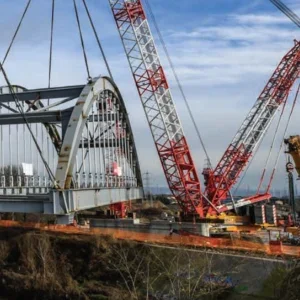Today there is a push to make the trade safe by developing certification schemes that will certify riggers at various skill levels. This is a good start but there is the danger that these programmes will undercut existing training, meant to develop well-rounded tradespeople.
The certification programmes on the street today seem to be aimed primarily at the crane rigger with a major focus on the up/down motions of a crane. Granted that the meat and potatoes of our trade is the construction industry and the usage of cranes to support building projects. But this certification might lead to the idea that this is all the rigger is required to do. This is wrong, and will have unintended consequences when the next generation of riggers take the field without the throughly-trained old-timers to fall back on.
Right now we are training the next generation of workers using the knowledge of workers who went through a rounded training regime. This next generation of workers are being trained in ‘multi-tasking’ and the resultant watered down skills levels. What happens when these folk are called upon to train the next generation? Somewhere there still needs to be a program for dedicated, full-time riggers to use as a benchmark.
Many tasks can be catered for by simple training courses and sessions on the job. These programmes work for those tasks where there are no suprises on the job and the worker can refer back to management in the event of a problem. This thinking has led to the removal of any training not needed at that particular moment.
Most of the commercial training on the market is excellent and does a tremendous service in reducing injuries, damage and down time. But too often the material out there introducing folk to the rigging trade is a one-time blast of information that sometimes gives them false confidence.
As a former apprentice instructor for the US Navy, I have been involved with not only this type of training but also a formal four-year apprenticeship that graduated journeymen riggers. I think I can state that the graduate apprentice came away with more initial skills and knowledge than a new employee who has gone through an eight-hour rigging class. There is a cost to this type of programme, but the old saying ‘you get what you pay for’ still holds true.
I went through an apprenticeship programme administered by the US Navy at a civilian shipyard on the east coast of the USA. This apprenticeship program consisted of trade-related academic subjects and a thorough hands-on schedule of guided experience on the job by experienced riggers.
The academic portion had classroom courses in maths, communication skills and mechanical drawing. The trade component of the classroom section centred on the rigging process and various standards, manufacturing and testing processes needed on the job. The hands-on portion was built around six month tours in the fields of crane rigging, industrial plant rigging, gear manufacturing and gear testing.
At the end of the apprenticeship, the student had been exposed to all the aspects of the trade they would face in their coming career. The programme gave management the opportunity to evaluate the strengths and weaknesses of the apprentice. In addition to the trade skills he or she learned, the student was also given additional training in communication skills, print reading and basic shop drawing techniques. Upon completion, a student of this programme as it exists today earns a journeyperson’s certificate and an associate degree.
As we’re seeing in the financial world, there is value to tried and true systems. There is still a place in today’s work force for ‘old fashioned’ systems of training that have proven successful since the time of Pharaoh Cheops, the builder of the great pyramid of Giza.






